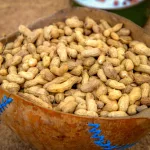What is Nigerian Rice
Nigerian rice, simply put, is rice that is grown and produced in Nigeria, a country located in West Africa. It’s an essential staple in Nigerian cuisine and is enjoyed by millions of people across the country. Nigerian rice is known for its unique flavors, textures, and cooking methods that set it apart from rice produced in other parts of the world.
Here are some key things to know about Nigerian rice:
Varieties: There are various varieties of rice grown in Nigeria, but the most common and popular one is the long-grain parboiled rice. This rice variety is partially cooked in the husk before milling, which gives it a distinct nutty flavor and makes it less sticky when cooked.
Culinary Significance: Nigerian rice is a fundamental component of many traditional Nigerian dishes. It’s used to prepare dishes like Jollof rice, Fried rice, Coconut rice, and many more. Jollof rice, in particular, is a beloved Nigerian dish made with rice cooked in a flavorful tomato-based sauce, often with spices and vegetables.
Local Production: Nigeria has a strong tradition of rice cultivation, with many local farmers contributing to its production. In recent years, there has been a significant push to increase domestic rice production to reduce the country’s dependence on imported rice.
Cultural Importance: Rice plays a crucial role in Nigerian culture and is a centerpiece at many celebrations and gatherings. It’s a symbol of hospitality and is often served generously to guests.
Economic Impact: The cultivation and processing of rice also have significant economic implications in Nigeria. It provides employment opportunities for many people, from farmers to rice mill workers and distributors.
Government Initiatives: The Nigerian government has implemented various policies and initiatives to support local rice production, aiming to make the country self-sufficient in rice production and reduce the need for imports.
Flavorful Seasoning: Nigerian rice is typically cooked with a variety of seasonings and spices, which give it its rich and vibrant flavor. These can include ingredients like onions, peppers, garlic, ginger, and local spices.
Nigerian rice is a vital and culturally significant food item in Nigeria. Its unique flavor and role in traditional dishes make it a beloved part of Nigerian cuisine. The country’s efforts to boost domestic rice production are helping to ensure a steady supply of this essential staple for its population.
Comparative Analysis of Nigerian rice
comparative analysis of Nigerian rice, considering it in relation to other types of rice commonly found in the market.
1. Nigerian Rice vs. Imported Rice:
Source: Nigerian rice is locally grown and produced within the country, while imported rice is sourced from various countries, including Thailand, India, and the United States.
Freshness: Nigerian rice is often considered fresher since it doesn’t go through the long shipping and storage processes that imported rice does.
Flavor: Nigerian rice has a distinct nutty flavor, partly due to the parboiling process, which sets it apart from some imported rice varieties that may have a more neutral taste.
Economic Impact: Supporting Nigerian rice helps boost the local economy and provides livelihoods for farmers and workers. Importing rice can have economic implications, including foreign exchange costs.
2. Nigerian Rice vs. Basmati Rice:
Grain Type: Nigerian rice is typically long-grain, while Basmati rice is a fragrant, long-grain rice variety known for its slender, elongated grains.
Aroma: Basmati rice is famous for its distinctive aroma, which is absent in Nigerian rice. The aroma of Basmati is often described as nutty or floral.
Texture: Basmati rice has a delicate, fluffy texture when cooked, while Nigerian rice, especially the parboiled variety, tends to be firmer and less sticky.
Culinary Use: Nigerian rice is commonly used in West African dishes like Jollof rice and Fried rice, whereas Basmati rice is popular in South Asian and Middle Eastern cuisines for dishes like Biryani and Pilaf.
3. Nigerian Rice vs. Jasmine Rice:
Origin: Nigerian rice comes from West Africa, while Jasmine rice is primarily associated with Southeast Asian countries like Thailand and Cambodia.
Aroma: Jasmine rice has a natural floral scent, which is why it’s often referred to as fragrant rice. Nigerian rice doesn’t have this aromatic quality.
Grain Length: Jasmine rice is usually medium-grain and shorter than Nigerian long-grain rice.
Stickiness: Jasmine rice tends to be stickier when cooked, making it suitable for dishes where a sticky texture is desired.
4. Nigerian Rice vs. Arborio Rice:
Usage: Arborio rice is a short-grain rice variety primarily used for making risotto, while Nigerian rice is versatile and used in a wide range of dishes.
Texture: Arborio rice has a creamy texture when cooked due to its high starch content, while Nigerian rice varieties are typically firmer.
Culinary Application: Nigerian rice is ideal for dishes like Jollof rice, Fried rice, and Pounded Yam, while Arborio rice shines in creamy rice-based dishes.
The choice between Nigerian rice and other rice varieties depends on personal preference and the specific culinary application. Nigerian rice is celebrated for its unique flavor and cultural significance, while other rice varieties like Basmati, Jasmine, and Arborio offer distinct qualities that cater to different cuisines and preferences.
The Nutritional Properties of Nigerian Rice:
1. Carbohydrates:
Nigerian rice is predominantly a carbohydrate-rich food. It provides a significant source of energy due to its high carbohydrate content, making it a staple in the Nigerian diet.
2. Dietary Fiber:
Nigerian rice, especially brown or unprocessed varieties, contains dietary fiber. This fiber aids in digestion, helps maintain bowel regularity, and may contribute to a feeling of fullness, which can be beneficial for weight management.
3. Protein:
While rice is not as protein-rich as other grains like wheat or quinoa, it still contains a moderate amount of protein. Nigerian rice provides essential amino acids, which are the building blocks of proteins needed for various bodily functions.
4. Vitamins:
Nigerian rice contains several B vitamins, including thiamine (B1), riboflavin (B2), and niacin (B3). These vitamins play essential roles in metabolism, energy production, and overall health.
5. Minerals:
Rice is a source of important minerals such as magnesium, phosphorus, and selenium. These minerals are vital for bone health, cell function, and antioxidant defense.
6. Low in Fat:
Nigerian rice is naturally low in fat, which can be beneficial for those watching their fat intake. However, the method of preparation, such as frying or adding fatty sauces, can significantly increase the fat content of rice-based dishes.
7. Gluten-Free:
Rice is naturally gluten-free, making it a suitable choice for individuals with gluten sensitivities or celiac disease.
8. Antioxidants:
Some varieties of Nigerian rice, particularly those with bran layers intact (such as brown rice), contain antioxidants like phenolic compounds. These antioxidants help protect cells from oxidative damage and may have health benefits.
9. Low Sodium:
Rice is naturally low in sodium, which is important for individuals who need to monitor their sodium intake, especially those with hypertension or heart conditions.
10. Calories:
The calorie content of Nigerian rice varies depending on the type and cooking method. Generally, one cup of cooked Nigerian rice provides around 200-250 calories, primarily from carbohydrates.
Proximate Analysis/Composition (%) Food energy(kCal per 100 g)
| Rice varieties | Moisture | Protein | Fat | Crude fibre | Ash | Carbohydrate |
| Ofada rice | 13.19±0.08e | 6.81±0.05c | 0.50±0.03b | 1.40±0.02a | 1.53±0.04a | 76.57±0.10e |
| Abakaliki rice | 13.04±0.07e | 6.93±0.06c | 0.54±0.04b | 1.48±0.02a | 1.77±0.04a | 76.24±0.10e |
| Ekpoma rice | 13.97±0.10e | 6.72±0.05e | 0.47±0.03b | 1.40±0.02a | 1.69±0.04a | 75.75±0.10e |
| Igbimo rice | 13.10±0.08 e | 6.89±0.05e | 0.51±0.03 b | 1.69±0.02 a | 1.78±0.04a | 76.03±0.010a |
It’s important to note that the nutritional content of Nigerian rice can vary depending on factors such as the rice variety, processing method (e.g., parboiled, white, or brown rice), and cooking techniques. To maximize the nutritional benefits, it’s advisable to choose whole-grain Nigerian rice varieties like brown or unprocessed rice, as they retain more of their natural nutrients compared to highly processed white rice.
Incorporating a variety of foods, including vegetables, proteins, and fruits, alongside Nigerian rice in your diet can help ensure a balanced and nutritionally rich meal.
The Health Benefits of Nigerian Rice:
1. Energy Source:
- Nigerian rice is an excellent source of carbohydrates, which are the body’s primary energy source. Consuming rice provides a quick and sustained energy boost, making it a valuable staple for daily activities and physical endurance.
2. Dietary Fiber:
- Brown or unprocessed Nigerian rice is rich in dietary fiber, which supports digestive health. Fiber helps prevent constipation, promotes regular bowel movements, and may aid in weight management by promoting a feeling of fullness.
3. Nutrient Content:
- Nigerian rice contains essential nutrients, including B vitamins (thiamine, riboflavin, niacin), magnesium, phosphorus, and selenium. These nutrients play various roles in maintaining overall health, including supporting metabolism, bone health, and immune function.
4. Gluten-Free:
- Nigerian rice is naturally gluten-free, making it suitable for individuals with gluten sensitivities or celiac disease. It provides a safe and versatile carbohydrate option for those with dietary restrictions.
5. Low in Fat:
- Rice is naturally low in fat, making it a heart-healthy choice when prepared without excessive fats or oils. It can be part of a low-fat diet, which is beneficial for heart health.
6. Weight Management:
- The combination of carbohydrates and dietary fiber in Nigerian rice can help promote a feeling of fullness and reduce overall calorie intake. This can be advantageous for weight management and preventing overeating.
7. Reduced Risk of Chronic Diseases:
- Consuming whole-grain Nigerian rice, such as brown rice, may be associated with a reduced risk of chronic diseases like type 2 diabetes, heart disease, and certain types of cancer. The fiber and nutrients in brown rice offer protective benefits.
8. Versatility in Cooking:
- Nigerian rice is incredibly versatile and can be used in a wide range of dishes, allowing for diverse and nutritious meal options. When combined with vegetables, lean proteins, and healthy fats, it contributes to a balanced diet.
9. Potential Antioxidant Benefits:
- Some Nigerian rice varieties, especially those with bran layers intact, contain antioxidants that help protect cells from oxidative damage. These antioxidants may contribute to overall health and well-being.
10. Cultural and Social Significance:
- Sharing meals prepared with Nigerian rice is a cultural and social tradition in Nigeria. It fosters a sense of community, family bonding, and cultural identity, which can have positive effects on mental and emotional well-being.
It’s important to note that while Nigerian rice offers various health benefits, the overall nutritional impact can be influenced by factors such as portion size, cooking methods, and the choice of accompaniments and toppings. To maximize the health benefits, it’s advisable to choose whole-grain Nigerian rice varieties and prepare them using healthy cooking techniques, such as steaming or boiling, and by incorporating a variety of nutritious ingredients into meals.
Chemical Properties of Nigerian Rice:
Mineral Content of Nigerian Rice:
|
Weight |
100g |
|
Calcium |
5.9mg |
|
Iron (Fe) |
0.7mg |
|
Magnesium |
35mg |
|
Phosphorus (P) |
124mg |
|
Potassium (k) |
95mg |
|
Sodium (Na) |
3mg |
|
Zinc (Zn) |
1.1mg |
|
Copper (Cu) |
0.17mg |
|
Manganese |
mg |
Amino Acid Profile(g/100g crude protein) of Nigerian rice
| Essential amino acids | Ofada rice | Abakaliki rice | Ekpoma rice | Igbimo rice |
| Lysine (Lys) | 0.59 ±0.03 b | 0.60±0.04 b | 0.48±0.04 b | 0.56±0.03 b |
| Histidine (His) | 2.27±0.00 a | 2.34±0.03 a | 2.31±0.01 a | 2.28±0.01a |
| Threonine (Thr) | 3.81±0.01 c | 3.76±0.01 c | 3.79±0.02 c | 3.80±0.02 c |
| Valine (Val) | 4.94±0.00 e | 4.97±0.00 e | 5.02±0.01 e | 4.89±0.00 e |
| Methionine (Met) | 2.29±0.00a | 2.31±0.00 a | 2.36±0.00 a | 2.28±0.00 a |
| Isoleucine (Ile) | 4.10±0.00 d | 4.09±0.03 d | 4.06±0.01 d | 4.01±0.01 d |
| Leucine (Leu) | 8.30±0.01 f | 8.26±0.01f | 8.29±0.01 f | 8.33±0.01 f |
| Phenylalanine (Phe) | 9.48.05±0.01 g | 9.61±0.02 g | 9.47±0.01 g | 9.53±0.02 g |
| Total EAA | 37.78 | 37.94 | 37.78 | 37.68 |
Non-essential Amino Acids
| Aspartic acid (Asp) | 4.68±0.03g | 4.71±0.03g | 4.76±0.01g | 4.69±0.03g |
| Serine (Ser) | 4.39±0.00f | 4.61±0.01f | 4.43±0.01f | 4.59±0.01f |
| Proline (Pro) | 1.80±0.00d | 1.83±0.00d | 1.88±0.01d | 1.92±0.00d |
| Alanine (Ala) | 3.46±0.00e | 3.51±0.03e | 3.48±0.01e | 3.43±0.01e |
| Cystine (Cys) | 0.76±0.00a | 0.73±0.00a | 0.78±0.00a | 0.72±0.00a |
| Tyrosine (Tyr) | 2.11±0.01c | 2.16±0.01c | 2.10±0.01c | 2.17±0.01c |
| Tryptophan (Try) | 0.38±0.01b | 0.29±0.01b | 0.24±0.01b | 0.35±0.01b |
| Total NEAA | 18.58 | 18.84 | 18.67 | 18.87 |
Vitamins Content of Nigerian Rice (mg/100g)
| Components | Ofada rice | Abakaliki rice | Ekpoma rice | Igbimo rice |
| Thiamine | 0.10±0.00a | 0.08±0.03a | 0.11±0.01a | 0.10±0.01a |
| Niacin | 2.11±0.01d | 2.06±0.01d | 2.18±0.01d | 2.13±0.01d |
| Riboflavin | 0.04±0.00a | 0.05±0.00a | 0.04±0.01a | 0.04±0.00a |
| Vitamin A | 0.28±0.01c | 0.26±0.01c | 0.23±0.01c | 0.29±0.01c |
| Vitamin E | 0.86±0.00 b | 0.82±0.00 b | 0.91±0.01 b | 0.84±0.00 b |
Heavy Metal Composition (µg/kg) of Nigerian Rice
| Components | Ofada rice | Abakaliki rice | Ekpoma rice | Igbimo rice |
| Arsenic | 1.30±0.05a | 1.30±0.05a | 1.45±0.07c | 1.40±0.07b |
| Lead | 0.98±0.04c | 0.90±0.03b | 0.92±0.03bc | 0.89±0.02a |
| Cadmium | 1.12±0.01a | 1.30±0.03c | 1.28±0.03bc | 1.24±0.02b |
| Mercury | 1.06±0.01a | 1.00±0.01a | 1.18±0.02b | 1.15±0.01b |
| Chromium | 0.91±0.02c | 0.86±0.01a | 0.89±0.01b | 0.93±0.02c |
Ways to Use Nigerian Rice:
Nigerian rice is incredibly versatile and can be used in a variety of delicious dishes. Here are some popular ways to use Nigerian rice:
- Jollof Rice: Jollof rice is arguably one of the most famous Nigerian rice dishes. It’s made by cooking rice in a flavorful tomato-based sauce with spices, onions, and various vegetables. It’s often served at celebrations and gatherings.
- Fried Rice: Nigerian Fried Rice is a colorful and flavorful dish made by stir-frying cooked rice with vegetables, proteins (such as chicken, shrimp, or beef), and a blend of spices. It’s a favorite at parties and special occasions.
- Coconut Rice: Coconut rice is a creamy and aromatic dish made by cooking rice with coconut milk and spices. It’s a delightful combination of sweet and savory flavors and pairs well with various side dishes.
- White Rice: Plain white rice is a versatile base for many Nigerian dishes. It can be served with stews, soups, grilled meats, or fried plantains. It’s a common accompaniment to Nigerian dishes like Egusi soup or Okra soup.
- Rice and Beans: This is a popular Nigerian combination where rice and beans are cooked together to create a hearty and nutritious meal. It’s often served with stewed or sauced proteins.
- Pepper Soup and Rice: Nigerian pepper soup, made with a spicy broth and various proteins (such as goat meat or fish), pairs wonderfully with plain white rice. The rice helps balance the heat of the soup.
- Jollof Spaghetti: Similar to Jollof rice, this dish features spaghetti cooked in the same flavorful tomato sauce with spices and vegetables. It’s a unique twist on the classic Jollof flavor.
- Rice Porridge: Rice porridge is a comforting and filling dish made by cooking rice with broth or water until it becomes soft and creamy. It can be sweet or savory and is often enjoyed for breakfast or as a comforting meal.
- Ofada Rice: Ofada rice, also known as local rice, is a Nigerian specialty. It’s often served with a spicy pepper sauce and is a must-try for those looking to explore Nigerian cuisine.
- Rice and Vegetable Stews: Nigerian rice pairs beautifully with various vegetable stews, such as Egusi stew, Okra stew, or Bitterleaf stew. These stews are made with a variety of vegetables and protein sources.
- Rice and Suya: Suya is a popular Nigerian street food made from skewered and grilled meat, typically served with a spicy peanut sauce. Enjoying rice with suya and its flavorful sauce is a delightful combination.
- Rice Balls: Rice can be shaped into balls and served with soups or stews. These rice balls are often used to scoop up the accompanying sauce.
These are just a few of the many ways to use Nigerian rice in your culinary adventures. Nigerian cuisine offers a rich tapestry of flavors and textures, and rice plays a central role in creating delicious and satisfying meals.
Recipes Using Nigerian Rice
Here are recipes for three classic Nigerian rice dishes: Jollof Rice, Fried Rice, and Coconut Rice.
1. Nigerian Jollof Rice:
Ingredients:
- 2 cups long-grain parboiled rice
- 1/4 cup vegetable oil
- 1 onion, finely chopped
- 1 red bell pepper, diced
- 1 green bell pepper, diced
- 2 cups tomato paste or blended tomatoes
- 1 teaspoon thyme
- 1 teaspoon curry powder
- 1 teaspoon paprika
- 1/2 teaspoon cayenne pepper (adjust to taste)
- Salt to taste
- 2 cups chicken or vegetable broth
- 1 cup green peas (frozen or fresh)
- 1 cup cooked and diced chicken (optional)
- Fried plantains for garnish (optional)
Instructions:
- Rinse the rice thoroughly and set it aside to drain.
- In a large pot, heat the vegetable oil over medium heat. Add the chopped onions and sauté until they become translucent.
- Stir in the diced red and green bell peppers and cook for a few minutes until they soften.
- Add the tomato paste or blended tomatoes and cook, stirring frequently, until the mixture thickens and the oil begins to separate from the tomato sauce.
- Add the thyme, curry powder, paprika, cayenne pepper, and salt. Stir to combine.
- Pour in the chicken or vegetable broth and bring the mixture to a boil.
- Add the drained rice to the pot and stir well to coat it with the tomato mixture.
- Reduce the heat to low, cover the pot, and let the rice simmer for about 25-30 minutes, or until it’s cooked and the liquid has been absorbed. You can add more broth or water if needed.
- In the last few minutes of cooking, add the green peas and diced cooked chicken (if using). Stir gently to combine.
- Once the rice is cooked, fluff it with a fork, garnish with fried plantains if desired, and serve hot.
2. Nigerian Fried Rice:
Ingredients:
- 2 cups long-grain parboiled rice
- 1/4 cup vegetable oil
- 1 onion, finely chopped
- 1 red bell pepper, diced
- 1 green bell pepper, diced
- 1 cup green beans, chopped
- 1 cup carrots, diced
- 1 cup cooked and diced chicken, shrimp, or beef
- 1/2 cup green peas (frozen or fresh)
- 2 tablespoons soy sauce
- 1 teaspoon curry powder
- 1/2 teaspoon thyme
- Salt and black pepper to taste
- 2 eggs, beaten (optional)
- Spring onions or scallions for garnish
Instructions:
- Rinse the rice thoroughly and cook it according to package instructions. Once cooked, spread it on a tray to cool and prevent sticking.
- In a large skillet or wok, heat the vegetable oil over medium-high heat.
- Add the chopped onions and sauté until they become translucent.
- Stir in the diced red and green bell peppers, carrots, and green beans. Cook for a few minutes until the vegetables begin to soften.
- Add the cooked chicken, shrimp, or beef to the skillet and stir.
- Mix in the cooked rice and stir-fry for about 5 minutes, ensuring the rice is well-coated with the vegetables and protein.
- Drizzle soy sauce over the rice and stir to evenly distribute it.
- Add the curry powder, thyme, salt, and black pepper. Continue to stir-fry for another 5 minutes, allowing the flavors to meld.
- If desired, push the rice mixture to one side of the skillet and pour the beaten eggs into the other side. Scramble the eggs until cooked, then mix them into the rice.
- Stir in the green peas, garnish with chopped spring onions or scallions, and serve hot.
3. Nigerian Coconut Rice:
Ingredients:
- 2 cups long-grain parboiled rice
- 1 can (13.5 oz) coconut milk
- 1 1/2 cups water
- 1 onion, finely chopped
- 2 cloves garlic, minced
- 1 teaspoon ginger, minced
- 2 tablespoons vegetable oil
- 1 teaspoon curry powder
- 1/2 teaspoon thyme
- 1/2 teaspoon paprika
- Salt and black pepper to taste
- 1/2 cup green peas (frozen or fresh)
- Fried plantains or roasted chicken for garnish (optional)
Instructions:
- Rinse the rice thoroughly and set it aside to drain.
- In a large pot, heat the vegetable oil over medium heat. Add the chopped onions and sauté until they become translucent.
- Stir in the minced garlic and ginger, and cook for another minute until fragrant.
- Add the curry powder, thyme, paprika, salt, and black pepper. Stir well to combine with the onion mixture.
- Pour in the coconut milk and water, and bring the mixture to a gentle boil.
- Add the drained rice to the pot and stir to combine with the coconut milk mixture.
- Reduce the heat to low, cover the pot, and let the rice simmer for about 20-25 minutes, or until it’s cooked and most of the liquid has been absorbed.
- In the last few minutes of cooking, add the green peas and stir gently.
- Once the rice is done, fluff it with a fork and serve hot. You can garnish it with fried plantains or roasted chicken for extra flavor.
These recipes offer a taste of the diverse and flavorful world of Nigerian rice dishes. Enjoy exploring these traditional and delicious options!
Potential Side Effects and Things to Remember
While Nigerian rice can be a delicious and nutritious addition to your diet, there are some potential side effects and important considerations to keep in mind:
1. Allergies:
- Some individuals may have allergies to certain ingredients commonly used in Nigerian rice dishes. For example, peanuts are often used in Nigerian cuisine, so if you have a peanut allergy, be cautious when dining on dishes that may contain peanuts or peanut products.
2. Spiciness:
- Nigerian cuisine often incorporates spicy ingredients like cayenne pepper and scotch bonnet peppers. If you are sensitive to spicy foods or have digestive issues, be mindful of the level of spiciness in dishes and adjust it to your tolerance.
3. Portion Control:
- Nigerian rice dishes can be hearty and calorie-dense. Overeating can lead to weight gain and digestive discomfort. Practice portion control to enjoy these dishes in a balanced way.
4. Dietary Restrictions:
- If you have dietary restrictions or specific health concerns, such as diabetes or hypertension, be mindful of the ingredients used in Nigerian rice dishes and make modifications as needed. Consider using whole-grain rice varieties and reducing added sugars or salt when possible.
5. Food Safety:
- Ensure that the rice and other ingredients are properly cooked and stored to prevent foodborne illnesses. Refrigerate leftovers promptly and reheat them thoroughly before consumption.
6. Sodium Content:
- Some Nigerian rice dishes can be high in sodium, especially if they are prepared with store-bought seasoning cubes or sauces. High sodium intake can contribute to high blood pressure, so monitor your sodium intake and use low-sodium alternatives when possible.
7. Balanced Diet:
- While Nigerian rice dishes are delicious, it’s important to maintain a balanced diet by incorporating a variety of foods, including vegetables, fruits, lean proteins, and whole grains. Use Nigerian rice as part of a diverse and nutritious meal plan.
8. Hydration:
- Spicy Nigerian dishes may lead to increased thirst due to their heat. Stay hydrated by drinking plenty of water or other non-alcoholic beverages.
9. Individual Sensitivities:
- Pay attention to how your body responds to certain ingredients or spices used in Nigerian rice dishes. If you have sensitivities or digestive issues, consult with a healthcare professional for guidance.
10. Cultural Considerations:
When dining on Nigerian rice in a communal or cultural setting, be respectful of local customs and traditions, such as proper etiquette and table manners.
While Nigerian rice dishes can be delicious and culturally significant, it’s essential to be mindful of individual dietary needs and potential side effects. Enjoy these dishes in moderation and consider making adjustments to suit your preferences and health requirements.
The bottom line is that Nigerian rice is a versatile and flavorful ingredient that plays a central role in Nigerian cuisine. It offers a range of culinary possibilities, from classic dishes like Jollof Rice and Fried Rice to the comforting flavors of Coconut Rice. However, it’s essential to enjoy Nigerian rice in moderation and be mindful of potential side effects, especially for individuals with allergies or dietary restrictions.
To make the most of Nigerian rice:
- Explore its diverse culinary applications, from savory and spicy to sweet and creamy dishes.
- Pay attention to portion sizes to maintain a balanced diet and avoid overindulgence.
- Consider using whole-grain Nigerian rice varieties for added nutrition.
- Be aware of spice levels and adjust them to your taste and tolerance.
- Keep in mind individual dietary needs and restrictions.
- Prioritize food safety and proper storage when preparing and enjoying Nigerian rice dishes.
In essence, Nigerian rice is a delicious and culturally significant ingredient that can be savored while being mindful of its potential effects on your health and well-being.
References
- FAOSTAT, Rice, Production/Crops/World for 2016. Food and Agricultural Organization of the United Nations, Statistics Division (FAOSTAT).
- USA Rice Federation. The natural history of rice. Online Food Cult. Encyclopedia, 2002; pp. 1-4.
- National Research Council, Lost Crops of Africa: Grains, National Academies Press, Washington, DC, 1996; 17.
- Food and Agricultural Organization of the United Nations.”Rice is Life”. Rome,
- Saka, J. O and Lawal, B. O. Determinants of adoption and productivity of improved rice varieties in southwestern Nigeria. African Journal of Biotechnology. 2009; Vol. 8 (19): pp. 4923 – 4932.
- US Environmental Protection Agency.”Chemical Contaminant Rules”. New York, 2017.
- Adeyeye, S. A. O. Quality Evaluation and Acceptability of Cookies Produced from Rice (Oryzaglaberrima) and Soybeans (Glycine max) Flour Blends, Journal of Culinary Science & Technology, 2018, doi:10.1080/15428052.2018.1502113. Accessed 28 August, 2018; 4pm
CrossRef - Jones, M. P. The rice plant and its environment, 1995, WARDA Training Guide 2: 27 –30.
- Horna, D.; Smale, M. and Vonopper, M. Farmers’ willingness to pay for seed-related information on rice varieties in Nigeria and Benin. Education Plan Transfer Discussion paper 142, 2005; 11- 12.
- Obadina, O.A, Arogbokun, C. A, Soares, A., Piler de Carvalho C. W. “Changes in nutritional and physicochemical properties of pearl millet (Pennisetumglaucum) Ex-Borno variety flour as a result of malting”, Journal of Food Science and Technology, 2017; 54(13): 4442–4451.
CrossRef - Xheng X, Lan, Y. Effects of drying temperature and moisture content on rice taste quality. Eng. Int., 2007; 49: 24-277.
CrossRef - Official Methods of Analysis of Association of Official Analytical Chemists (17th edn), USA, Maryland. 2000; pp. 452-456.
- Ebuehi O. A, Oyewole A. C. Effect of cooking and soaking on Physical characteristics, nutrient composition and sensory evaluation of indigenous and foreign rice varieties in Nigeria, African Journal of Biotechnology, 2007; 6(8): 1016-1020.
- Edeogu C. O, Ezeonu F. C, Okaka A. N. C, Ekuma C. E, EIom S. O. Proximate Compositions of Staple Food Crops in Ebonyi State, South Eastern Nigeria. International Journal of Biotechnology and Biochemistry, 1: 1-8. (2007).
- Sotelo A, Saisa V, Montolvo I, Hernandez M, Hernandez L. Chemical composition of different fractions of 12 Mexican varieties of rice obtained during milling. Cereal Chemistry,1990; 67(2): 209-212.
- Eggum B. O, Juliano B. O, Maningat C. C. Protein and energy utilization of rice milling fractions by rats. Plant Food for Human Nutrition, 1982; 31: 371-376.
CrossRef - Moongngarm A and Saetung N. Comparison of chemical compositions and bioactive compounds of germinated rough rice and brown rice. Food Chemistry. 2010; 122: 782-788.
CrossRef - Asaduzzaman M., Haque M.E., Rahman J., Hasan S.M.K., Ali M.A., Akter M.S., Ahmed, M. Comparisons of physiochemical, total phenol, flavonoid content and functional properties in six cultivars of aromatic rice in Bangladesh. African Journal of Food Science, 2013; 7 (8): pp. 198-203.
CrossRef - Ibukun, E. O. Effect of prolonged parboiling duration on proximate composition of rice. Scientific Research and Essays,2008; 3(7): 323-325.
- Willis, R.B.H., L.B. Palipane and H. Greenfield. Composition of Australian Foods. Rice. Food Technology, Australia. 1982; 34:66-68.
- Webb, B. D Criteria of rice quality in the U.S. In: Juliano. B., ed., Rice: Chemistry and technology. St. Paul, Minnesota, Association of Cereal Chemistry Inc.,1985; 774.
- Juliano, B. O. Rice: Chemistry and Technology. American Association of Cereal Chemists, Paul, MN. 1985.
- Zarkadas, Constantinos G., Harvey D. Voldeng, Zi Ran Yu, Keijin Shang, and Peter L. Pattison. “Comparison of the Protein Quality of Five New Northern Adapted Natto Soybean Cultivars by Amino Acid Analysis”, Journal of Agricultural and Food Chemistry, 1997; 45(6), pp 2013–2019. doi: 1021/jf9604697
CrossRef - Martínez-Villaluenga C. “Kinetics of free protein amino acids, free non-protein amino acids and trigonelline in soybean (Glycine max L.) and Lupin (Lupinusangustifolius L.) sprouts”, European Food Research and Technology,2006; 224: 177–186, doi10.1007/s00217-006-0300-6
CrossRef - Adeyeye, S. A. O., O. B. Oyewole, O. Obadina, O. E. Adeniran, H. A. Oyedele, A. Olugbile, and A. M. Omemu. Effect of smoking methods on microbial safety, polycyclic aromatic hydrocarbon, and heavy metal concentrations of traditional smoked fish from Lagos State, Nigeria, Journal of Culinary Science & Technology,2016; 14:2: 91-106, doi: 10.1080/15428052.2015.1080644.
CrossRef - Adeyeye S.A.O and Omoniyi, S. A. Quality Attributes, Chemical and Microbial Safety of Street-Vended Smoked West Africa Ilisha(Ilishaafricana) from major markets in Ibadan, Oyo State, Nigeria, International Journal of Aquaculture,2015; 5(32): 1-8.
CrossRef - Adeyeye, Samuel A. O., Olusola B. Oyewole, Olusegun A. Obadina, A. M. Omemu, O. E. Adeniran, H. A. Oyedele, AdetolaOlugbile, and Saheed A Omoniyi. (2017) Effect of Smoking Methods on Quality and Safety of Traditional Smoked Fish from Lagos State, Nigeria, Journal of Culinary Science & Technology, 2017; 15:1: 17-35, doi: 10.1080/15428052.2016.1185072
CrossRef - Adeyeye S. A. O., Oyewole O. B., Obadina, A. O., Omemu A. M., Adeniran O. E., Oyedele H. A. and Abayomi S. O. Quality and Safety Assessment of Traditional Smoked fish from Lagos State, Nigeria., International Journal of Aquaculture, 2015; 5(15): 1-9. doi: 10.5376/ija.2015.05.0015.
CrossRef - Adeyeye, Samuel A. O., and John O. Akingbala. Quality, Functional, and Sensory Properties of Cookies from Sweet Potato–Maize Flour Blends, Journal of Culinary Science & Technology, 2016; 14:4: 363-376, doi: 10.1080/15428052.2016.1160016.
CrossRef - EFSA Panel on Contaminants in the Food Chain (CONTAM). “Scientific Opinion on Arsenic in Food”. EFSA Journal. European Food Safety Authority. 2009; 7 (10): doi:10.2903/j.efsa.2009.1351.
CrossRef - FAO/WHO, Codex Alimentarius Commission. Food additives and contaminants. Joint FAO/WHO food standards programme, ALINORM 01/12A: 2001; 1-289.
- US Food and Drug Administration.”Arsenic in Rice and Rice Products”. 2017.











